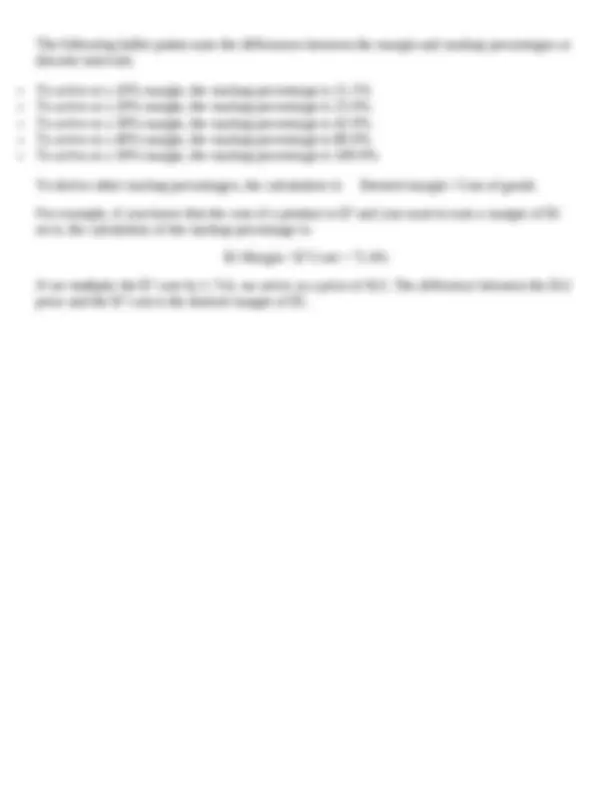



Study with the several resources on Docsity

Earn points by helping other students or get them with a premium plan


Prepare for your exams
Study with the several resources on Docsity

Earn points to download
Earn points by helping other students or get them with a premium plan
Community
Ask the community for help and clear up your study doubts
Discover the best universities in your country according to Docsity users
Free resources
Download our free guides on studying techniques, anxiety management strategies, and thesis advice from Docsity tutors
The concepts of gross margin and markup, which are important financial metrics for businesses. Gross margin is the percentage of total sales revenue that a company retains after incurring the direct costs associated with producing goods and services. Markup is the amount by which the cost of a product is increased to derive the selling price. The document also explains the difference between margin and markup and how they are calculated. It is important for businesses to understand these concepts to make informed pricing decisions and maximize profits.
Typology: Study notes
1 / 2

This page cannot be seen from the preview
Don't miss anything!


What is 'Gross Margin' Gross margin is a company's total sales revenue minus its cost of goods sold, divided by the total sales revenue, expressed as a percentage. The gross margin represents the percent of total sales revenue that the company retains after incurring the direct costs associated with producing the goods and services sold by a company. The higher the percentage, the more the company retains on each dollar of sales to service its other costs and obligations. Gross profit is the profit a company makes after deducting the costs associated with making and selling its products, or the costs associated with providing its services. Gross profit will appear on a company's income statement or can be calculated with this formula: Gross profit = revenue - cost of goods sold. Selling price The actual final price of a product or service that company charges a purchaser to buy the item. By definition , the markup percentage calculation is cost X markup percentage , and then add that to the original unit cost to arrive at the sales price. For example, if a product costs $100, the selling price with a 25% markup would be $125: Gross Profit Margin = Sales Price – Unit Cost = $125 – $100 = $25. Difference between margin and mark up Margin (also known as gross margin) is sales minus the cost of goods sold. For example, if a product sells for $100 and costs $70 to manufacture, its margin is $30. Or, stated as a percentage, the margin percentage is 30% (calculated as the margin divided by sales). Markup is the amount by which the cost of a product is increased in order to derive the selling price. To use the preceding example, a markup of $30 from the $70 cost yields the $100 price. Or, stated as a percentage, the markup percentage is 42.9% (calculated as the markup amount divided by the product cost). It is easy to see where a person could get into trouble deriving prices if there is confusion about the meaning of margins and markups. Essentially, if you want to derive a certain margin, you have to markup a product cost by a percentage greater than the amount of the margin, since the basis for the markup calculation is cost, rather than revenue; since the cost figure should be lower than the revenue figure, the markup percentage must be higher than the margin percentage. The markup calculation is more likely to result in pricing changes over time than a margin- based price, because the cost upon which the markup figure is based may vary over time; or its calculation may vary, resulting in different costs which therefore lead to different prices.
The following bullet points note the differences between the margin and markup percentages at discrete intervals: To arrive at a 10% margin, the markup percentage is 11.1% To arrive at a 20% margin, the markup percentage is 25.0% To arrive at a 30% margin, the markup percentage is 42.9% To arrive at a 40% margin, the markup percentage is 80.0% To arrive at a 50% margin, the markup percentage is 100.0% To derive other markup percentages, the calculation is: Desired margin / Cost of goods For example, if you know that the cost of a product is $7 and you want to earn a margin of $ on it, the calculation of the markup percentage is: $5 Margin / $7 Cost = 71.4% If we multiply the $7 cost by 1.714, we arrive at a price of $12. The difference between the $ price and the $7 cost is the desired margin of $5.